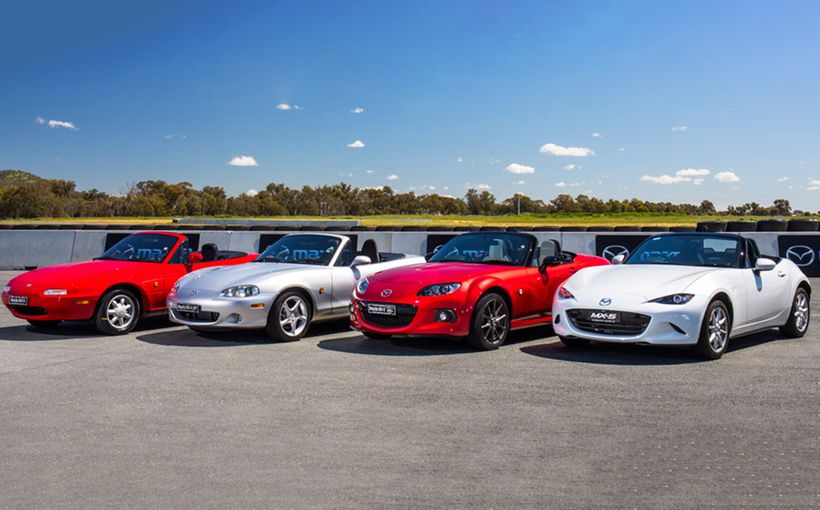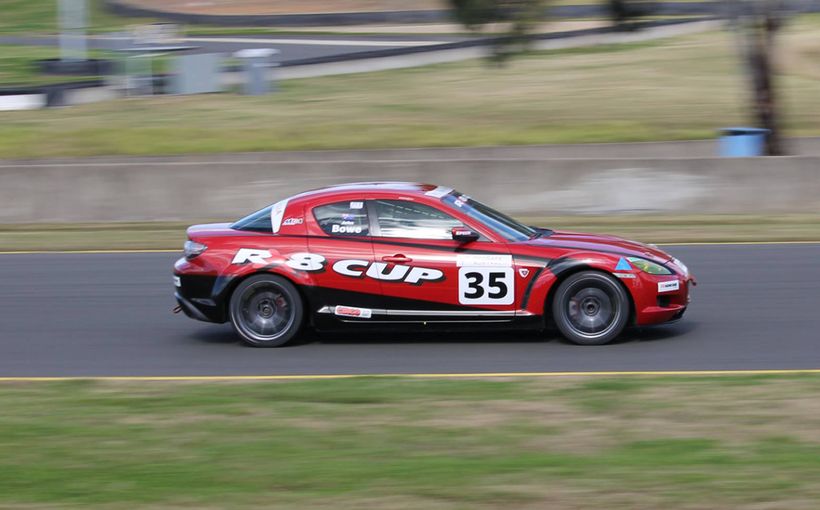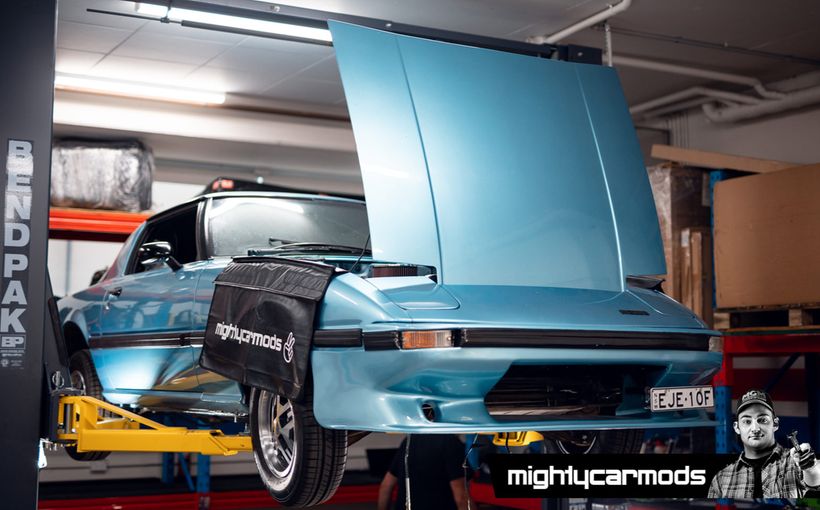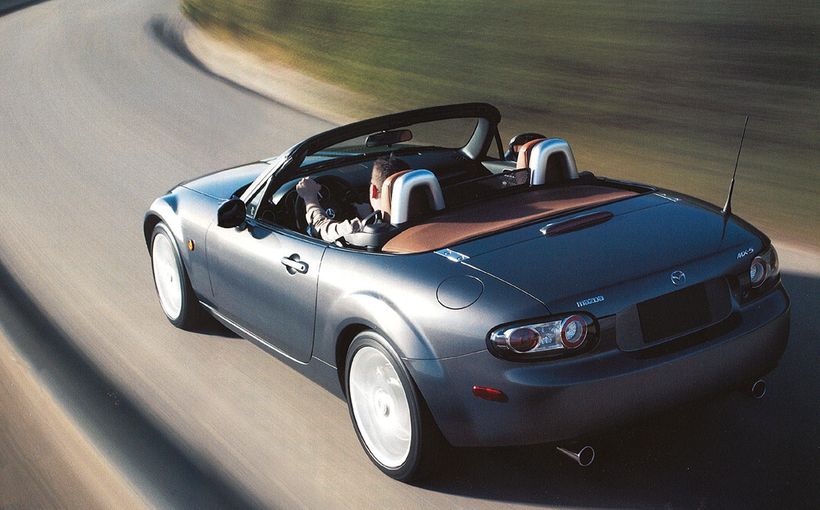Mazda 1300: The $5000 Bathurst Champ!

Mazda’s proud history in Australian touring car racing is largely built on its bold decision to back rotary power. However, perhaps less known is that a non-rotary model – the Mazda 1300 – also competed with great success in the early 1970s, winning the small car division (Class A) at Bathurst and proving how affordable racing at Mount Panorama could be.
An article in the July 1975 issue of Sports Car World proved that a new Mazda 1300 could be purchased and race-prepared for the Hardie-Ferodo 1000 for as little as $5000. That’s only about $34,000 in today’s money, which shows how the relative costs of racing have ballooned since then.
And how the annual Bathurst race, which was once accessible to many amateur Aussie racers that wanted to have a go, is now well out of reach for all but the wealthiest professionals (read all about this SCW article later in this story).
Back in the early 1970s, during the Mazda 1300’s heyday at Bathurst, most media and race fans were focused on the annual stoush for outright honours between Ford and Holden. However, some of the most fiercely competitive battles were being fought at the other end of the grid yet didn't command the same attention.

That’s because Class A catered for the smallest, cheapest and least powerful cars in the race’s price-based class structure. As a result, they were always the first cars to be lapped by the outright contenders and were often referred to as the ‘tiddlers’ in race reports, which created mobile chicanes for the faster cars to weave through.
Fact is, the Bathurst Class A battles during this period were generally closer and more exciting than the outright contests, fought out between official works teams or quality dealer-backed entries representing Mazda, Datsun and Toyota.
The Mazda 1300 sedan, released in 1970, was similar to the 1200 sedan and coupe released the previous year but - crucial for Bathurst duty - was fitted with a larger 1272cc SOHC four offering 75bhp at 6000rpm.

Suspension was MacPherson strut front and leaf-spring live rear axle, with front disc brakes, rear drums and 13-inch wheels. All very conventional, but its tiny 780kg kerb weight and aero-efficient shape helped it to a 93mph (150km/h) top speed with well-balanced handling thanks to a 56F/44R weight distribution.
Its performance was very close to that of its showroom rivals - the Datsun 1200 and Toyota Corolla. As a result, the fastest Class A cars were extremely close in lap times and the amount of rule-bending that went on, which made life hell for the scrutineers, only proved how close the competition was and how high the stakes were in Class A.
All three Japanese marques and their dealers knew that a successful motor sport campaign could help make big inroads into the Australian car market, when they were still often being dismissed as ‘those funny little Japanese cars’. A Bathurst class win on Sunday was like money in the bank on Monday, as dealers could rely on an instant boost in showroom traffic.

1970 Hardie-Ferodo 500
By the time Mazda’s new 1300 sedan was ready for its Class A (up to $1,960) Bathurst debut in 1970, when the race was for showroom stock ‘Series Production’ cars, arch rivals Datsun and Toyota were already well established.
1960 Armstrong 500 winner John Roxburgh headed up the official Datsun Racing Team from his well-equipped workshop in South Melbourne, while local Toyota assembler AMI operated a well-drilled racing operation from its Port Melbourne plant. Both had enjoyed Class A victories at Bathurst in the late 1960s.
The new Mazdas were backed by the marque’s state distributors and enthusiastic dealers. And they certainly had strength in numbers with six of the 1300 sedans facing three of the new Datsun 1200s, three of the latest ‘1200’ versions of the KE10 Corolla and two of the new Ford Escort 1300s, all of which were making their Bathurst debuts.

It was a hell of a fight from start to finish and after more than six and a half hours and almost 500 miles (800km) of intense racing, the works-entered Barry Tapsell/John Leighton Datsun 1200 emerged as the Class A winner at its first attempt.
The new Mazda 1300 were mighty impressive, with Bernie Haehnle/Neil Revell finishing a close runners-up less than one minute behind the winning Datsun. Mazda 1300s also finished third, fifth, seventh and eighth, with only one retirement caused by crash damage. The latest Corolla 1200s, though, were outclassed in what was the KE10’s fourth and final Bathurst start for AMI.
The new Mazdas also won their class in both of the other big Series Production endurance races in 1970, the Sandown Three Hour and Surfers Paradise 250.

1971 Hardie-Ferodo 500
The retail price threshold for Class A eligibility was raised to $2,150 for the 1971 race but the competition amongst the main protagonists was just as fierce as the previous year. Four dealer-backed Mazda 1300s fronted this time, facing two Datsun Racing Team 1200s and a privately entered KE20 Corolla 1200.
Several of the top Class A drivers elected to do the entire race distance solo, but it was a long and arduous task requiring supreme levels of concentration and physical stamina for more than six hours behind the wheel without a break.

During another day of mercilessly tough Class A warfare, Datsun Racing Team driver James Laing-Peach drove a flawless race to take the chequered flag more than a lap ahead of the second-placed Mazda 1300, also driven solo by the talented John Leffler.
However, Laing-Peach’s glory was short-lived after his Datsun 1200 was disqualified after post-race scrutineering determined that its camshaft was not representative of ‘normal’ mass-production tolerances. As a result, Leffler was elevated to the top spot, with Mazda 1300s filling three of the top five places in class.

1972 Hardie-Ferodo 500
What a battle this promised to be, with Datsun doubling its factory attack from two to four 1200s against a four-pronged Mazda 1300 effort.
After another intense day-long struggle, in which mercurial Datsun works driver ‘Wild’ Bill Evans fought a lone hand against several Mazda 1300s, it was Mazda driver Geoff Perry who crossed the line first ahead of Evans.

However, it was Mazda’s turn to have its post-race celebrations cut short this time, as Perry’s winning Mazda 1300 was disqualified by scrutineers for irregularities relating to the inlet manifold and carburettor. The Mazda team returned fire, lodging a counter-protest against the second-placed Datsun 1200 for using what it claimed was a non-standard cylinder head, inlet manifold and camshaft!
Mazda’s protest was dismissed and Bill Evans and his Datsun 1200 were declared the Class A winners. However, the 1300’s successes in the endurance-based Australian Manufacturers Championship (ManChamp) held over five rounds including Bathurst, delivered Mazda the Class A title and fourth place overall in the 1972 series.

1973-1976 Hardie-Ferodo 1000
Surprisingly there were no Mazda 1300s competing at Bathurst in 1973, the first year the race was run under new ‘Production Touring – Group C’ rules which allowed for limited modifications to standard road cars to improve their performance and durability under racing conditions.
1973 was also the first year the race was extended from 500 miles (800km) to 1000km in recognition of Australia’s new metric system of measurement, with a minimum of two drivers per car and maximum driving durations for each. The previous price-based class structures were changed to new groupings from A to D based purely on engine capacities.
The reason for Mazda’s sudden departure from the Class A battle with Datsun was never made clear. However, the introduction of the new rotary-powered RX-3 in Class B (1301-2000cc) that year, alongside existing RX-2 entries in Class C (2001-3000cc), points to a wholesale shift by Mazda racers to rotary power under the new rules.
Even so, the 1300 continued to appear at Bathurst from 1974 until the demise of Class A (up to 1300cc) in 1976, when the closing speeds between small and large cars had become so great (up to 80km/h) that it was no longer considered safe to continue.

In 1974 there was only one Mazda 1300 in the race shared by Lynn Brown and Paul Hamilton, but it joined a long list of retirements after getting caught out by the atrocious wet conditions and retiring with crash damage on lap 124 of 163. A Mazda 1300 coupe shared by Terry Shiel/Tony Mulvihill crashed in practice and was a non-starter.
The following year the same car, this time shared by Brian Porter/John Ainsley, finished fifth in Class A behind an Alfa Junior, Datsun 1200 coupe and two Mini Cooper Ss, which finished first and third in the final year of the venerable British car’s homologation.
Porter and Ainsley returned in 1976 for the venerable Mazda 1300’s sixth and final appearance in The Great Race and again they finished fifth in class behind a Mini Clubman GT, two Honda Civics and its long-time nemesis, the Datsun 1200, which convincingly won Bathurst’s final Class A battle.
On reflection, the Mazda 1300 certainly produced an enviable record of racing success. In six Bathurst appearances in Class A, it scored one win, three seconds and a third. It also won its class in the 1972 ManChamp and provided some of the toughest competition for rival Japanese brands Datsun and Toyota.

Case study: How to race at Bathurst for $5000!
Back in the 1970s the annual Bathurst 1000 rivalled the Melbourne Cup as a race that also stopped the nation. On the first Sunday each October, millions of TV viewers around the country would be glued to their TV sets, watching the Seven Network’s live coverage.
It was also a time when the race’s bulging 60-plus entry list included many drivers who were not household names like Moffat and Brock, yet had the necessary credentials to be granted a start alongside them in Australia’s greatest motor race. And many were found in the lower-priced, lower capacity classes which offered the most inexpensive way to compete.
By 1975 the humble Mazda 1300 had gone from having strength in numbers during the early 1970s factory wars to being something of a rare curiosity. This was the catalyst for a Sports Car World article that year, which claimed that for a mere $5000 you could find yourself on the starting grid for the next Hardie-Ferodo 1000.
To his credit, SCW reporter AJ Van Loon emphasised that the hardest part of actually getting a start at Bathurst was getting your entry accepted. Race organisers did not want classes full of the same make and model, so would always look favourably at any entry that offered something different. He suggested a budding Bathurst rookie, with the necessary racing experience, think the same way. And that the Mazda 1300 was an ideal choice.

“Adding it all up we discovered you could put yourself on the grid at Bathurst for under $5000 – including the cost of the car and insurance against damage!” SCW claimed. “It’s a realistic figure and is based on what it cost James Mason Motors, Sydney’s Brookvale Mazda dealer, to run a Class A Mazda 1300 at Bathurst last year (driven by Lynn Brown/Paul Hamilton).”
At the time a new Mazda 1300 cost around $3000 (or $20,500 today). SCW advised running up a couple of thousand kilometres on the road as an initial shakedown, so that if anything did fall off the dealer could fix it for free under the new car warranty
Race preparation of the Mason Motors Mazda 1300 started with a full strip-down of the engine for a thorough inspection and balancing by Waggott Engineering for $32. Waggott also ground a new competition camshaft for $80 and supplied a big 45mm DCOE Weber twin-choke carburettor and adapter for the stock inlet manifold for another $80. Other minor machining required to get the whole engine package A1 was another $50. All up engine costs were $242, or less than $2000 in today’s money.
Class A cars typically weighed less than 1000kg (the Mazda 1300 was only 780kg), which helped enormously in minimising preparation and running costs. Mason Motors found no need to modify the standard gearbox and differential, nor the brakes which when fitted with the mandatory front pads and rear linings supplied by race sponsor Hardie-Ferodo were more than adequate for the job.

Such a light car could also complete the full race distance on one set of Dunlop racing slicks which cost about $50 each, or just under $400 apiece today. Wheel costs were also capped because standard RX-4 vented steel rims could bolt straight on. However, the centres had to be moved slightly outwards so that the 1300’s standard track width wasn’t illegally increased.
Aftermarket suspension specialist Selby’s made some simple tweaks to the Mazda’s suspension, fitting a stiffer front anti-roll bar, stiffer springs all round with a lower ride height and adjustable Armstrong shocks. No costings were provided, but the initial set up was so good that it quickly became a case of set-and-forget for the Mazda crew.
Other Bathurst modifications included fitting a Bond Roll Bars half-cage for about $85 (a full cage would have cost roughly double that) and installation of a second-hand 77-litre aluminium long-range fuel tank with internal safety bladder for $100. For those two items, about $1500 in today’s money.
The innovative but short-lived Motor Racing Insurance Services even offered cover for Bathurst racers in those days. For premiums between $180 and $250, MRIS provided $3000 cover for practice sessions and the race. For $5000 cover (almost $40,000 today) the premium rose to $300 (about $2300), which was still pretty affordable peace-of-mind for a race like Bathurst.

SCW: “Add that lot together and you’d still have change from $5000 but, if you’re no mechanic, you may have to shell out some more brass to have the engine built plus the various odds and ends that always seem to wreck the planned budget. Nevertheless five grand should be the most it need cost you to front a Class A car at Bathurst.”
AJ Van Loon briefly track-tested the car at Sydney’s Amaroo Park, during which he claimed “you are absolutely dead strapping flat for most of the time.” He said the Waggott-fettled 1.3 litre engine felt “unburstable”. Lynn Brown claimed it was safe to 8500rpm, but he always shifted up at 7500rpm to keep the engine within its peak power band.
SCW’s tester quickly discovered that driving a small Class A car like the Mazda 1300 required ability and bravery in equal measure. With such modest power, it was essential to drive at “full tilt” as much as possible, because any loss of momentum was very hard to regain.
“It also calls for better than average anticipation. When racing a Class A car at Bathurst you spend half your time looking in mirrors for the traffic that is going to come blasting past and the other half looking where you are going.”

This view was backed by Paul Hamilton, who co-drove the Mason Motors entry with Lynn Brown at Bathurst the previous year, where a good Class A car could lap Mount Panorama in just over three minutes. Interestingly, that was just as quick as the best times set by the Firth/Gibson XR Falcon GT when it won the 1967 race!
“The trick is to judge where the car behind is going to pass you so that you can move over when necessary, but with a minimum of interference to your own line,” Hamilton explained. “A little car will go around a corner just as quick as any V8 but, of course, lacks the acceleration to stay with one coming out. You’ll find that you will constantly have to move away from the ideal line but this in itself becomes a challenge in maintaining regular lap times.”
It’s interesting to note that the Mason Motors Mazda 1300 did have its entry accepted for the 1975 and 1976 Bathurst 1000s. The fact it was the only one entered each time would have appealed to race organisers for the reasons explained. The fact that drivers Brian Porter and John Ainsley also claimed top-five finishes on both occasions proved that SCW’s advice was spot-on. And that the humble Mazda 1300 remained an affordable and resilient Bathurst racer from start to finish.









